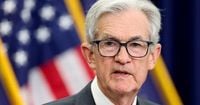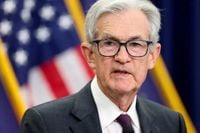Federal Reserve Chair Jerome Powell’s recent remarks at the Jackson Hole Economic Symposium have sent ripples through financial markets, fueling speculation about imminent interest rate cuts and casting a spotlight on the U.S. labor market’s growing fragility. The anticipation of a policy pivot has ignited optimism in sectors ranging from equities to cryptocurrencies, but analysts warn that the euphoria may be premature—and fraught with risk.
On August 22, 2025, Powell addressed a crowd of economists, policymakers, and investors at the Fed’s annual gathering in Wyoming, a venue often associated with major monetary policy announcements. This year, the stakes were especially high: U.S. economic growth has slowed, inflation remains above the central bank’s 2% target, and unsettling labor market data has emerged. Powell wasted no time acknowledging the shifting landscape. “Downside risks to employment are rising. And if those risks materialize, they can do so quickly in the form of sharply higher layoffs and rising unemployment,” he warned, according to Reuters and Glenview Trust’s summary of the event.
His remarks were more than just cautionary—they signaled a subtle but significant shift in the Fed’s priorities. For the first time in recent memory, Powell focused on labor market risks before addressing inflation, hinting that the central bank might soon prioritize job preservation over price stability. He noted that recent soft employment reports, including massive negative revisions, were economic warning signs. “The baseline outlook and shifting balance of risks may warrant adjusting our policy stance,” Powell said, adding that the Fed could “proceed carefully as we consider our changes to our policy stance.”
This dovish tone did not go unnoticed by Wall Street. The CME FedWatch Tool, which tracks market expectations for Fed moves, showed an 81% probability of a 25 basis point rate cut at the September 17 meeting shortly after Powell’s speech—a figure that later climbed to 87% as reported by Reuters. Barclays and BNP Paribas, two major global banks, promptly revised their forecasts, now expecting not only a September cut but another in December. Deutsche Bank followed suit, shifting its own projections to forecast two cuts before year’s end. Barclays economists, led by Jonathan Millar, wrote, “We now expect two 25 bp cuts this year, in September and December,” while BNP Paribas’s Calvin Tse noted, “Powell made clear that the Fed intends to deliver a ‘fine-tuning’ rate cut in September unless the data dictates otherwise.”
The labor market data backing up these policy shifts is sobering. According to the Department of Labor, continuing unemployment claims for the week ending August 9 reached 1,972,000—the highest level since November 2021. Initial claims, too, have edged up, exceeding economist expectations at 235,000. The four-week moving average has risen, signaling mounting pressure on job seekers. These trends suggest that displaced workers are struggling longer to find new employment, a development Powell himself referenced during his Jackson Hole address.
The implications of these labor market strains extend far beyond Main Street. In the cryptocurrency market, the prospect of Fed rate cuts has unleashed a wave of bullish sentiment. Santiment, a blockchain analytics firm, reported that social media chatter about potential rate cuts reached an 11-month high on August 24. This surge in optimism, fueled by Powell’s dovish hints, has driven major cryptocurrencies sharply higher: Ethereum soared to a four-year high, and XRP broke above $3, with trading volumes spiking in tandem. The CME FedWatch Tool reflected that roughly 77% of market participants expected a September rate cut, according to aInvest and FastBull.
But Santiment’s analysts urge caution. Historically, spikes in positive sentiment around Fed policy have often preceded short-term market peaks. “Such rapid sentiment shifts can also signal caution is warranted,” the firm warned, noting that overbought conditions could lead to a period of consolidation or even correction. The crypto market’s sensitivity to macroeconomic cues is undeniable, but that very sensitivity makes it vulnerable to sharp reversals if expectations are not met.
Not all experts are convinced that an initial rate cut would provide immediate relief. Markus Thielen of 10x Research argued, “Bitcoin first sells off when China devalues or the Fed cuts, as the first cut might not be so impactful and also confirms economic weakness.” Economist Timothy Peterson offered a more dire assessment: “What it needs is a trigger. I think that trigger may be as simple as the Fed not cutting rates at all this year.” Both perspectives underscore the complexity of the current environment, where monetary easing could be interpreted as a sign of deeper economic trouble rather than a straightforward boon for risk assets.
Meanwhile, U.S. equity markets have responded with a mix of optimism and caution. The S&P 500 posted a small gain for the week, with a notable 1.5% rally following Powell’s comments. Tech giants like Microsoft, Meta, and Nvidia rebounded, while more domestically focused and economically sensitive stocks outperformed their defensive counterparts. The Russell 2000 and Russell Midcap indexes, often seen as barometers for the health of smaller businesses, led the charge. Banks, too, enjoyed a stellar week, benefiting from the prospect of a more accommodative Fed.
Still, uncertainty abounds. The next major data points—the weekly unemployment claims report on August 28 and the monthly Employment Situation jobs report on September 5—will be crucial in shaping the Fed’s path. As Glenview Trust and Benzinga emphasize, any upside surprise in job growth could dampen expectations for a September cut, while further deterioration would likely cement the case for easing.
Powell’s Jackson Hole speech has set the stage for what could be a pivotal moment in U.S. monetary policy. The central bank faces a delicate balancing act: act too soon, and it risks reigniting inflation; wait too long, and the labor market could unravel. Investors, meanwhile, are left parsing every word and data point, hoping to stay one step ahead of the next move.
As the countdown to the Fed’s September meeting continues, markets remain on edge, oscillating between hope and trepidation. Whether the anticipated rate cut delivers the relief that investors crave—or simply confirms deeper economic woes—remains to be seen. For now, all eyes are on the data, and the stakes could hardly be higher.


